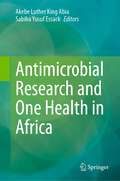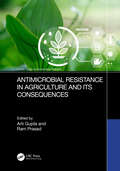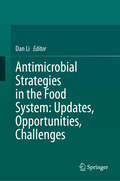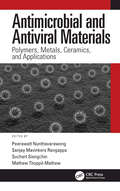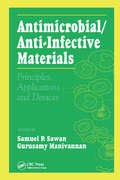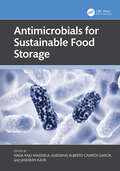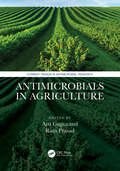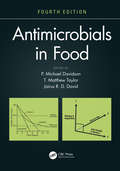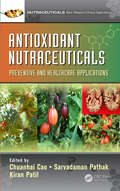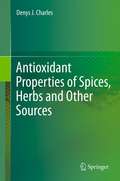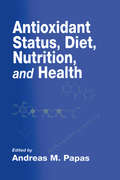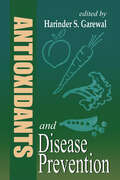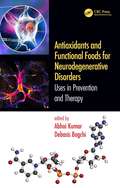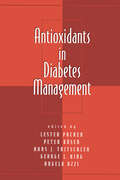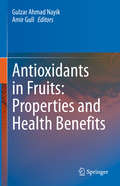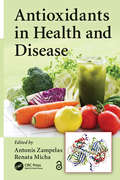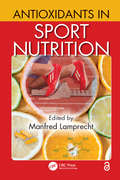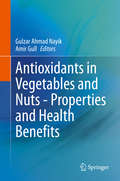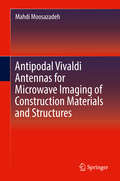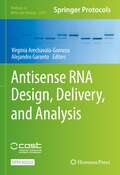- Table View
- List View
Antimicrobial Research and One Health in Africa
by Akebe Luther King Abia Sabiha Yusuf EssackAntimicrobial resistance is recognised among the world’s most challenging problems. Despite its global spread, Africa, specifically sub-Saharan Africa, is the most affected by this malaise. Poor living conditions and inadequate access to sanitation and potable water supplies are among contributing factors that have influenced a high disease burden on the continent, requiring extensive antimicrobials. Weak health systems and the absence of firm policies further aggravate the problem, as the use of antimicrobials is mostly unregulated. The increasing demand for animal protein to meet the starving populations’ demands has also influenced the use of these antimicrobials, including those banned on other continents, for food animal production. The ripple effect of indiscriminate use in humans and animals is the massive discharge of antimicrobials, their residues, antimicrobial-resistant microorganisms and their associated genes into the environment. This 14-chapter unique masterpiece presents the AMR problem in African, addressing the various compartments of the One Health – humans, animals, and the environment, to illustrate the need for concerted efforts in the fight against AMR, especially in Africa. Authors from the four cardinal points present diverse aspects of AMR in Africa, starting with behavioural and social drivers of AMR in Africa. Antimicrobial stewardship in an African context is also discussed. AMR in humans is presented through studies on antibiotic-resistant neonates and nontyphoidal Salmonella infections and the clinical relevance of the genetics of viral resistance. Topics on AMR in mastitis, biosecurity in animal farming and the linkage between disinfectants and AMR are discussed. The environmental dimension of AMR is discussed, notably in the aquatic environment, and its implication for aquaculture and irrigation and using nanomaterials to treat polluted waters from such environments are highlighted. Finally, Africa’s rich floral diversity is portrayed as an eco-friendly and cost-effective approach to combat AMR. Hopefully, the work presented will spur greater collaboration between scientists, environmental, animal and human health practitioners, the general population, and policymakers to assimilate and implement the One Health approach to combating AMR, rather than working in silos on their various sectors
Antimicrobial Resistance in Agriculture and its Consequences (Current Trends in Antimicrobial Research)
by Ram Prasad Arti GuptaThis book offers comprehensive coverage of all manifestations of resistance in combating infectious diseases and explores advances in antimicrobial resistance in agriculture and their applications in the fight against microbes. It discusses and compares biological, biochemical, and structural aspects of resistance and its evolution. This is a comprehensive tool covering all manifestations of antimicrobial resistance and microbial resistance genes. In addition, it also provides a variety of photographs, diagrams, and tables to help illustrate the material. Novel strategies to combat antimicrobial resistance are also described, emphasizing collaborative measures of control. The underlining molecular mechanisms, which depend not only on the microbe but on the specific drug (target) molecule, are highly diverse and are covered in great detail.Students, researchers, scientists, practitioners, academics, computational biologists, stakeholders, and policymakers can benefit from using Antimicrobial Resistance in Agriculture and its Consequences as a resource that addresses microbial biotechnology, microbiology, ethnopharmacology, toxicology, medicinal plant products, and all disciplines related to antimicrobial research.Features of the book: Covers antimicrobial resistance in agriculture with up-to-date research Includes recent references on each plausible antimicrobial resistance in agriculture Details the possible spread of antibiotic resistance bacteria from animals to humans Provides several perspectives in the resistance flux with modern agricultural practices Describes the public health impact of the use of antibiotics in agriculture Presents cutting-edge research on epigenetics, nanotechnology, and emergent antimicrobial technologies Outlines recent laws and regulatory guidelines in the federal agency, responsibility, and authority
Antimicrobial Strategies in the Food System: Updates, Opportunities, Challenges
by Dan LiIn 2023, world hunger and food insecurity looms as present as ever. The threat of foodborne illness is also alive and well, as 1 in 10 people fall ill each year from the consumption of contaminated food. Meanwhile, thirty percent of all the food produced on our planet is lost or wasted, due in large part to spoilage. In the face of these realities, as well as those of climate change, population growth, ecosystem degradation and increasing resource scarcity, the dire need for a more sustainable global food system can no longer be ignored. Consumers are not only more invested in sustainability than ever, but also more health conscious. Recent years have thus seen a proliferation of alternative antimicrobial strategies, all aiming to mitigate the risks inherent in developing new production systems while striving for longer-lasting food products. Antimicrobial Strategies in the Food System: Updates, Opportunities, Challenges elucidates the established methods of this rapidly evolving field and introduces cutting-edge technologies such as urban/indoor agriculture. With an emphasis on detailing each step in the chain of food production, the text demonstrates how safety begins with primary production, from agriculture to aquaculture, and remains paramount through to packaging and handling. Developing informed and updated definitions of the terms &“natural&” and &“sustainable,&” this book addresses the fragilities of the current food system and establishes possibilities for future research and practice.
Antimicrobial and Antiviral Materials: Polymers, Metals, Ceramics, and Applications
by Suchart Siengchin Sanjay Mavinkere Rangappa Peerawatt Nunthavarawong Mathew Thoppil-MathewEmerging microbial and viral infections are a serious challenge to health, safety, and economics around the world. Antimicrobial and antiviral technologies are needed to disrupt the progression and replication of bacteria and viruses and to counter their rapidly evolving resistance. This book discusses recent developments in materials science and engineering in combating infectious diseases and explores advances in antimicrobial and antiviral materials, including polymers, metals, and ceramics and their applications in the fight against pathogens. Features • Covers progress in biomimetic antimicrobial and antiviral materials and antimicrobial/antiviral bulk materials and coatings • Describes modern methods for disinfection of biomedical materials against microbial and viral infection resistance, especially for depressing novel coronavirus (COVID-19) • Details methods to improve material properties to have a longer service life in combating infection • Emphasizes chemical, physical, mechanical, tribological, and antimicrobial/antiviral properties • Offers current and future applications of emerging antimicrobial/antiviral technologies This book will be of interest to materials researchers and industry professionals focusing on antimicrobial and antiviral applications.
Antimicrobial/Anti-Infective Materials: Principles and Applications
by Gurusamy Manivannan Samuel P. SawanAs our consciousness of microbes increases, it appears that our desire to control our interactions with germs also increases in proportion. This is clearly demonstrated by examining the incredible growth in the number and sales volume of consumer products with antimicrobial claims. In the medical field as well, there is much interest in the use of
Antimicrobials for Sustainable Food Storage
by Naga Raju Maddela Jaskiran Kaur García, Gusdanis Alberto CamposFinding natural substances is worthwhile in food preservation. The principal motivation behind this edited volume, Antimicrobials for Sustainable Food Storage, is to collect and present widespread knowledge in the domain of sustainable food ingredients with antimicrobial properties. The book consists of two sections. The first section of this volume is about food ingredients as antimicrobials, and the second section discusses the recent advances in the applications of food ingredients.Interplay of various environmental factors favors the growth of different microorganisms during the food preservation process. Growth of undesirable microorganisms negatively influences the taste, smell, color, and texture of food. Therefore, sustainable food preservation is a challenging issue. Though several chemicals have emerged, inevitable health effects are commonly encountered by food preserve chemicals.Microbial products (nisin, enterocin, pentosin, sakacin, and pediocin) have immense importance in prolonging the shelf life of food substances by controlling food spoilage and pathogenic microbes. Yeasts and cyanobacteria are also potential candidates in the supply of food ingredients with significant antimicrobial properties. However, limited awareness of antimicrobials as food ingredients and the unavailability of a single source of the latest insights on such food ingredients in one place led to the motivation to produce this work.Key Features: Provides insights on natural antimicrobials in food preservation Underlines the importance of sustainable food packaging Offers knowledge on emerging trends in antimicrobial-based food storage Diverse applications are covered in different chapters. This book covers various antimicrobials as food preservatives, such as metabolites, natural products, essential oils, nanomaterials, L-arginine, polyphenols, phaeophyceae, and horchata. There are also chapters that focus on the applicability and prospective studies of essential oils, edible biofilms, biodegradable antimicrobials, and nanostructured lipid carriers in the food sector and the method for encapsulation of antimicrobials.
Antimicrobials in Agriculture (Current Trends in Antimicrobial Research)
by Ram Prasad Arti GuptaThis book offers comprehensive coverage of all manifestations of resistance in combating infectious diseases and explores advances in antimicrobials in agriculture and their applications in the fight against microbes. According to the World Health Organization, antimicrobial resistance is a major threat to global health because the number of alternative antibiotics is very limited. Antimicrobial resistance is a slow, evolutionary process that has been accelerated by human activities in the health, environment, and agriculture sectors. Due to their wide application, antibiotics and their residues have been found in almost all food products and natural ecosystems. This book appraises the drivers, impact, and mitigation of antimicrobials, with a focus on methods and targets. In addition, it also provides a variety of photographs, diagrams, and tables to help illustrate the material. The novel strategies to combat antimicrobial resistance are also described, emphasizing collaborative measures of control. The underlying molecular mechanisms, which depend not only on the microbe but on the specific drug molecule, are highly diverse and are covered in detail.Students, researchers, scientists, practitioners, academicians, biologists, microbiologists, stakeholders, and policymakers can benefit from current trends in antimicrobials in agriculture that address microbiology, microbial biotechnology, ethnopharmacology, toxicology, natural medicinal plant products, secondary metabolites, and all disciplines related to antimicrobial research.Features of the book: Covers antimicrobials in agriculture with up-to-date research Recent references on plausible antimicrobials in agriculture Public health impact of the use of antibiotics in agriculture Antimicrobial efficacy of medicinal plants Role of phytoalexins in agriculture Nanoparticles as antimicrobial agents Presents cutting-edge research on microbiology, nanotechnology, and emergent antimicrobial technologies
Antimicrobials in Food (Food Science and Technology)
by P. Michael Davidson, T. Matthew Taylor, and Jairus R. D. DavidFifteen years have passed since the 3rd Edition of Antimicrobials in Foods was published. It was arguably considered the "must-have" reference for those needing information on chemical antimicrobials used in foods. In the years since the last edition, the food industry has undergone radical transformations because of changes on several fronts. Reported consumer demands for the use of "natural" and "clean-label" antimicrobials has increased significantly. The discovery of new foodborne pathogen niches and potentially hazardous foods, along with a critical need to reduce food spoilage waste, has increased the need for suitable antimicrobial compounds or systems. Novel natural antimicrobials continue to be discovered and new research has been carried out on traditional compounds. These and other related issues led the editors to develop the 4th Edition of Antimicrobials in Foods. In the 4th Edition, the editors have compiled contemporary topics with information synthesized from internationally recognized authorities in their fields. In addition to updated information, new chapters have been added in this latest release with content on the use of bacteriophages, lauric arginate ester, and various systems for antimicrobial encapsulation and delivery. Comprehensive revisions of landmark chapters in previous editions including naturally occurring antimicrobials from both animal and plant sources, methods for determining antimicrobial activity, new approaches to multifactorial food preservation or "hurdle technology," and mechanisms of action, resistance, and stress adaptation are included. Complementing these topics is new information on quantifying the capability of "clean" antimicrobials for food preservation when compared to traditional food preservatives and industry considerations when antimicrobials are evaluated for use in food manufacture. Key Features: Covers all food antimicrobials, natural and synthetic, with the latest research on each type Contains 5,000+ references on every conceivable food antimicrobial Guides in the selection of appropriate additives for specific food products Innovations in antimicrobial delivery technologies and the use of multifactorial food preservation with antimicrobials are included
Antimicrobials in Livestock 1: A European Perspective
by Lucie PokludováThis first volume in a two-volume work enhances readers’ understanding of antimicrobial resistance mechanisms in selected bacterial species that cause diseases in major food producing animals. It provides an overview of the current legislation and policies seeking to regulate the authorisation, manufacturing, distribution and use of veterinary antimicrobials in practice in a way that helps to contain the spread of antimicrobial resistance. The focus is put on Europe, without neglecting the global context. Moreover, attention is paid to various uses of antimicrobials in livestock, considering both their risks and benefits, from the distant past to the present. Growth promotion, prophylaxis, metaphylaxis, diagnostics and treatment are discussed not only with regard to food production and animal health, but also considering the One Health concept, which combines public and animal health with environmental aspects. A summary of various systems for monitoring the use of antimicrobials is provided, as well as an overview of the diseases that European veterinarians most often treat with antimicrobials. In closing, the book addresses the complexity of recent measures that are of key importance for antimicrobial stewardship, e.g. biosecurity, vaccination and other preventive tools including the newest technologies like smart farming. The complete two-volume work provides an extensive review of various aspects related to the use of antimicrobials in veterinary medicine, especially considering major food producing species, their most common infectious diseases and causative pathogens, and mainly focusing on the situation in Europe, without ignoring the global context. While Volume I discusses more general aspects of antibiotic use such as regulatory, laboratory and practical issues from different perspectives, Volume II more specifically discusses medical aspects and the use of antimicrobials in cattle, pigs, poultry and horses, as well as pharmacokinetics and pharmacodynamics, two of the most important factors determining the success of treatment. In both volumes, each chapter confronts the reader with open questions to stimulate further discussions and future research on the topics covered.
Antimicrobials in Livestock 2: A European Perspective
by Lucie PokludováThis second volume of the two-volumes work “Antimicrobials in Livestock” offers an in-depth look at the antimicrobials commonly used in veterinary medical care of the major food producing animals pigs, poultry and cattle as well as horses, bringing to readers’ attention also pharmacokinetic and pharmacodynamic characteristics of these drugs. The individual chapters also provide a brief description of preventive tools as well as alternatives to conventional treatment options that could help minimise the use of antibiotics and combat the problems caused by increasing antimicrobial resistance. The focus is on Europe, without neglecting the global context. The complete two-volumes provide an extensive review of various aspects related to the use of antimicrobials in veterinary medicine. Volume I explores the use of antimicrobials in animals from the regulatory, practical as well scientific perspective and is targeted on EU policies and regulatory surroundings, providing also information on risks linked to the extensive use of antibiotics in livestock and highlighting importance of methods of laboratory testing for susceptibility and resistance, starting from phenotype tests and moving towards genetic analysis results providing molecular biology aspects. Each chapter confronts the reader with open questions to stimulate further discussions and future research on the topics covered. Volume II more specifically discusses medical aspects necessary for targeted, responsible, and evidence-based use of antimicrobials in cattle, pigs, poultry, and horses, as well as pharmacokinetics and pharmacodynamics as two of the most important factors necessary for proper dosing schedule setting of effective treatment. While the preface of the first volume started with questions, Volume II’s preface ends with them, having the intention to provoke more in depth and innovative thinking and might be the start of a new era, which is needed to keep antimicrobials working and available for the future generations both in human and veterinary medicine.
Antimonide-Related Strained-Layer Heterostructures: Theory, Methods, And Applications (Systems Innovation Book Ser.)
by Adedeji B. BadiruInterest in antimonide-related heterostructures is burgeoning due to their applications as light sources, diode lasers, modulators, filters, switches, nonlinear optics, and field-defect transistors. This volume, featuring contributions from leading researchers in the field, is the first book to focus on antimonide-related topics. It offers to both the beginning student and the advanced researcher a comprehensive review of the state of the art in this exciting new area of research.
Antioxidant Nutraceuticals: Preventive and Healthcare Applications (Nutraceuticals)
by Chuanhai Cao Sarvadaman Pathak Kiran PatilThis book addresses various clinical and sub clinical applications of antioxidant nutraceuticals, with a primary focus on preventive use for general wellness, common ailments, and such chronic illnesses as cancer and neurological applications. This unique book captures the applications of natural antioxidants, which have been used for thousands of years in Traditional Chinese Medicine and Ayurvedic Medicine as well as modern nutraceuticals formulations. It covers antioxidant applications in clinical scenarios including the historical perspective, basic antioxidant properties and applications, anti-inflammatory properties, and antioxidant applications in a variety of clinical conditions.
Antioxidant Polymers
by Giuseppe Cirilo Francesca IemmaAntioxidant Polymers is an exhaustive overview of the recent developments in the field of polymeric materials showing antioxidant properties. This research area has grown rapidly in the last decade because antioxidant polymers have wide industry applications ranging from materials science to biomedical, pharmaceuticals and cosmetics.
Antioxidant Properties of Spices, Herbs and Other Sources
by Denys J. CharlesThe scientific world and modern society today is experiencing the dawning of an era of herbal medicine. Extensive research has shown that aromatic plants are important anti-inflammatory, antioxidant, anti aging and immune boosting delectable foods, with the magic and miracle to boost our immune system providing us with extended and an improved quality of life. Apart from making bland recipes into welcoming or interesting victories, herbs and spices have stirred the minds of the research community to look deeper into its active components from a functional perspective. It is essential to present the scientific and medicinal aspect of herbs and spices together with the analysis of constituents, its medicinal application, toxicology and its physiological effects. Herbs and spices with high levels of antioxidants are in great demand as they tend to promote health and prevent diseases naturally assuring increased safety and reliability for consumers. Herbs and spices are not only known for taste and flavor, but today research has opened up a new realm in which the antioxidant properties of these aromatic plants provide preservation for foods and health benefits for consumers who look forward to concrete scientific research to guide them further and explore herbal medicine. The aim of this book is to create awareness in society about the reliability of medicinal properties of certain herbs and spices through scientific and scholarly research.
Antioxidant Status, Diet, Nutrition, and Health (Contemporary Food Science Ser. #9)
by Andreas M. PapasThis is the first book to integrate the biological, nutritional, and health aspects of antioxidant status. Fifty contributors integrate and transfer the knowledge of free radicals and antioxidants from the test tube to the laboratory of the biologist, clinical nutritionist, and medical researcher, as well as to the office of the dietician, nutritionist, and physician. Topics examined include factors affecting and methods for evaluating antioxidant status in humans; effect of diet and physiological stage (infancy, aging, exercise, alcoholism, HIV infection, etc.) on antioxidant status; and the role of antioxidant status in nutrition, health, and disease.
Antioxidants and Disease Prevention (Modern Nutrition)
by Harinder GarewalThe role of antioxidants and other nutritional agents in disease prevention is a widely discussed subject, attracting attention from professionals in all areas of medicine. This often-debated and rapidly evolving area of medicine could have important implications for how diseases are treated.
Antioxidants and Functional Components in Aquatic Foods
by Hordur G. KristinssonAntioxidants and Functional Components in Aquatic Foods compiles for the first time the past and present research done on pro and antioxidants in aquatic animals. The book addresses an area of extreme importance for aquatic foods, since lipid oxidation leads to such a large number of quality problems. Many of these problems are also seen in other muscle based foods, but are exaggerated in aquatic foods, so the book’s contents will be of great use and interest to other fields. Written by top researchers in the field, the book offers not only general overviews of lipid oxidation in aquatic foods and aquatic food pro and antioxidant systems, but also covers specifics and gives the latest information on the key pro and anti-oxidants derived from aquatic foods as well as some of the most recent and innovative means to control lipid oxidations in aquatic foods and food systems with fish oils. Coverage includes the latest research on the effects aquatic foods have on oxidative stress in the human body, an area of great interest recently. Additionally, a chapter is devoted to the latest techniques to measure antioxidative potential of aquatic foods, an area still in development and one very important to the antioxidant research community. Antioxidants and Functional Components in Aquatic Foods will be of great interest to the food science, medical, biochemical and pharmaceutical fields for professionals who deal with aquatic food products, muscle foods products (beef, pork, poultry etc), lipid oxidation, and pro-oxidant and antioxidant systems.
Antioxidants and Functional Foods for Neurodegenerative Disorders: Uses in Prevention and Therapy
by Debasis Bagchi Abhai KumarNeurodegenerative diseases, including Alzheimer’s and Parkinson’s disease, are a growing problem across the world’s aging population. Oxidative stress in the brain plays a central role in a common pathophysiology of these diseases. This book presents scientific research on the potential of antioxidant therapy in the prevention and treatment of neurodegenerative disorders.This book outlines the roles of oxidative stress and diabetes mellitus in neurodegeneration, describes the molecular mechanisms of neurodegenerative disorders including the roles of environmental pollutants and inflammatory responses, and explores mitochondrial dysfunction. It then describes the protective abilities of antioxidants – including vitamin D, tocotrienol and coenzyme Q10 – against neurodegeneration. The book demonstrates the therapeutic potential of ketogenic diets, and highlights the roles of medicinal plants, phytopharmaceuticals, traditional medicines and food nutrients in neuroprotection.Key Features: Explains damage caused by numerous neurodegenerative disorders and the possible protection offered by antioxidants and functional foods. Describes molecular mechanisms of neurodegeneration by oxidative stress, advancing age, diabetes and mitochondrial dysfunctions. Demonstrates protection offered by nutraceuticals, antioxidants, botanical extracts and functional foods. The book contains twenty-three chapters divided into six sections written by leading researchers. This book is essential reading for health professionals, dietitians, food and nutrition scientists and anyone wanting to improve their knowledge of etiology of neurodegenerative diseases.
Antioxidants in Diabetes Management (Oxidative Stress and Disease)
by Lester Packer Peter Roser Hans J. Tritschler George L. King Anglo A221This volume summarizes current understanding of the pathogenic role of oxidative stress in the onset and progression of diabetes and its complications, and presents results of studies aimed at regulating oxidatively induced complications through the use of antioxidants. Examines the presence of impaired microcirculation, capillary hypoxia, and
Antioxidants in Fruits: Properties and Health Benefits
by Gulzar Ahmad Nayik Amir GullThis book provides a comprehensive review of the antioxidant value of widely consumed fruits. Each chapter covers the botanical description, nutritional & health properties of these popular fruits. Fruits are one of the most important indicators of dietary quality and offer protective effects against several chronic diseases such as cardiovascular diseases, obesity, and various types of cancer. In order to effectively promote fruit consumption, it is necessary to know and understand the components of fruits. In addition to underscoring the importance of fruit consumption’s effects on human diet, the book addresses the characterization of the chemical compounds that are responsible for the antioxidant proprieties of various fruits.Given its scope, the book will be of interest to graduate and post-graduate students, research scholars, academics, pomologists and agricultural scientists alike. Those working in various fruit processing industries and other horticultural departments will also find the comprehensive information relevant to their work.
Antioxidants in Health and Disease
by Antonis Zampelas and Renata MichaAntioxidant use in health promotion and disease prevention either through dietary intake or supplementation is controversial. This book reviews the latest evidence-based research in the area, principally through prospective cohort studies and randomized controlled trials. It assesses major dietary antioxidants and discusses their use in diseases such as cancer, diabetes, stroke, coronary heart disease, HIV/AIDS, and neurodegenerative and immune diseases. The use of antioxidants in health is also discussed along with common adverse effects associated with antioxidant use.
Antioxidants in Sport Nutrition
by Manfred LamprechtAntioxidant use in sports is controversial due to existing evidence that it both supports and hurts athletic performance. This book presents information on antioxidants, specifically for athletes, and their roles in sports nutrition. It stresses how antioxidants affect exercise performance, health, and immunity. Chapters cover oxidative stress; basic nutrition for athletes; major dietary antioxidants; sports supplements; performance/adaptation to exercise; antioxidants role in health and immunity; reviews on vitamins C, E, beta-carotene, and minerals in sports nutrition; and roles polyphenols play in high-performance sport.
Antioxidants in Vegetables and Nuts - Properties and Health Benefits
by Gulzar Ahmad Nayik Amir GullThis book covers the nutritional and nutraceutical profiles of a wide range of popularly consumed vegetables and nuts. The first half of the book focuses on popular vegetables, and describes how higher vegetable consumption reduces the risk of diseases ranging from diabetes to osteoporosis, diseases of the gastrointestinal tract, cardiovascular diseases, autoimmune diseases and cancer. The book also includes an interesting section on the antioxidant potential of mushrooms. In turn, the second half discusses the nutritional value of various nuts. Nuts are nutrient-dense foods with complex matrices rich in unsaturated fats, high-quality protein, fiber, minerals, tocopherols, phytosterols and phenolics. The respective chapters illustrate how the consumption of nuts could ward off chronic diseases like hypertension, cancer, inflammation, oxidative stress, high blood pressure, coronary heart disease etc. In order to effectively promote vegetable and nut consumption, it is necessary to know and understand the nutritional and nutraceutical profiles of vegetables & nuts. Given its scope, the book will be of interest to students, researchers, food scientists, olericulturists, dietitians and agricultural scientists alike. Those working in the vegetable and nut processing industries, horticultural departments and other agricultural departments will also find the comprehensive information relevant to their work.
Antipodal Vivaldi Antennas for Microwave Imaging of Construction Materials and Structures
by Mahdi MoosazadehThe research described here develops and applies novel, ultra-wideband (UWB) antipodal Vivaldi antennas for high-resolution detection of defects and damages in composite construction materials and structures using their microwave and millimeter wave imaging. The author examines the challenges of applying the UWB microwave technique in that the technique is dependent on the operating frequency used for the specified material under test. In this context, the objectives of this research volume include, but are not limited to, development of a small UWB antenna at frequency range from 5 GHz - 50 GHz for microwave and millimeter wave imaging of wide range of low loss construction materials, design of a small UWB antenna operating for microwave and millimeter wave imaging of low loss and high loss materials for the purpose of detection of surface damages of concrete under low loss materials, and development of a UWB antenna at frequency range from 2 GHz - 27 GHz for microwave imaging of low loss and high loss materials such as concrete structures and layered structures for the purpose of detection of cavities inside concrete.
Antisense RNA Design, Delivery, and Analysis (Methods in Molecular Biology #2434)
by Virginia Arechavala-Gomeza Alejandro GarantoThis open access volume gathers a variety of models, delivery systems, and approaches that can be used to assess RNA technology for exploiting antisense as a therapeutic intervention. Beginning with a section on the design of antisense technology and their delivery, the book continues by covering model systems developed to evaluate efficacy, both in vivo and in vitro, as well as methods to evaluate preclinically the toxicity associated with these new potential drugs, and intellectual property considerations. Written for the highly successful Methods in Molecular Biology series, chapters include introductions to their respective topics, lists of the necessary materials and reagents, step-by-step, readily reproducible laboratory protocols, and tips on troubleshooting and avoiding known pitfalls. Authoritative and practical, Antisense RNA Design, Delivery, and Analysis provides basic knowledge and a large collection of methods to facilitate the work of newcomers to this vibrant and expanding field. This book was conceived thanks to the network DARTER (Delivery of Antisense RNA Therapeutics). DARTER is funded by the EU Cooperation of Science and Technology (COST), which aims to enhance interaction and collaborations between researchers in Europe and other countries.
